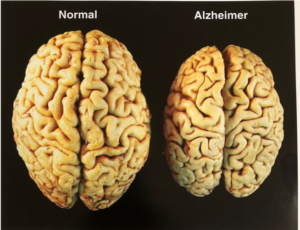It’s well known that Alzheimer’s disease is a progressive disease that worsens over time, hence the staging named in my previous posts of mild, moderate, and severe. But how does it start and why does it get progressively worse? What is actually happening in the brain?
What’s happening at a cellular level involves the plaques and tangles of Alzheimer’s disease you may

have heard of. An abnormally structured protein, amyloid, clumps into plaques around brain cells, inhibiting normal transmission of signals. Another
protein, tau, which provides internal structure to brain cells, becomes deformed and tangled so that the cells cannot fun
ction. These two abnormal proteins, which in a normal brain can be cleared, accumulate and gum up the system. Eventually, they build up to such a degree that they cause brain cells to actually die, and the brain physically shrinks.
We don’t know why this happens, except for rare genetic causes, and the plaques and tangles seem to be the end result. But what started this process is unknown.
We know that Alzheimer’s disease starts in the area of the brain called the hippocampus. This area is deep-seated, at about the level of your ears, one on either side. The hippocampus is responsible for filing new memories. Information enters the hippocampus, is sorted, then sent to another part of the brain for storage. If not functioning properly, new memories are lost because they can’t be stored. Radiologists can actually measure the size of the hippocampus on an MRI scan, and will comment if it appears smaller than expected.
From the hippocampus, the build up of plaques and tangles spreads, causing cell death in all areas of the brain. Some scientist say the spreading occurs in a systematic way, from one area to another. Others think it is happening throughout the brain, progressively affecting each section. Symptoms seen in patients, and listed in the staging I’ve discussed, can be traced to a particular area of the brain. This short video is an excellent representation of this progression.
Because I am a physician, I found it interesting to see how this disease progressively affected Harvey. If I set aside my personal feelings about his losses and just observed, it all made sense.
For an example, I’ll use cooking. In the early stages of the disease, Harvey cooked all our dinners without problems, using his memory and recipes.Then, he began to limit his repertoire of dishes because he couldn’t think of what to cook. Then he couldn’t remember those tried and true meals and couldn’t comprehend a recipe. Then he began to improvise, to odd results. Next, he could help with cooking by doing simple tasks when asked, and later, with more concrete direction. He could open cans, chop, pour, and stir with direction. And then he lost those skills.
That progression showed that first memory was affected (mild), then reading comprehension, judgement, and auditory comprehension (moderate), and lastly, motor skills (severe).
Alzheimer’s disease is heartbreaking. Watching a loved one lose their memory, their ability to think and comprehend, and eventually their motor skills is really tough. They have a broken, dying brain. Having a better understanding of what is actually happening can make it less scary and make you feel more empathic.
5 Responses
The video was so enlightening.
Very well done and your tie-in with Dr. Harmon’s cooking skills helped to put a picture to the words.
Thank you, Barbara! Someone showed me that video several years ago, and it has always stuck with me. Glad I could find it again!
This is the best explanation of Alzheimer’s that I have seen. I think I am Stage 3..Jo
Jo, I didn’t know! Do you want to talk?
The best illustration I have watched so far! It is beginning to be more clear with a better understanding I as I see my love one progress! So glad my sweet friend Susan introduced me to your blog! It takes a village!